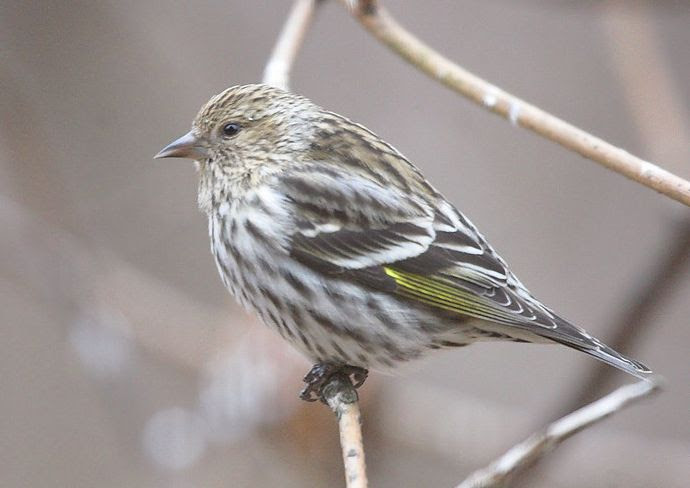Pine Siskin, Spinus pinus
Bill Rowe
Watch your feeders: Pine Siskins are here already. Like some other species that nest in the boreal forest (the pine/spruce/fir forest of Canada and the northernmost states), they are irruptive, which means that every few years they move south earlier and in larger numbers than usual. This is one of those years, and the siskins have already shown up by the dozens or even hundreds, mostly out in the fields gorging on the seed-heads of thistles, sunflowers, etc. They often join up with goldfinches, their close cousins, in mixed flocks that feed quietly for a while, then take off and go bounding around in search of another good spot. Both species are finches in the family Fringillidae, as are many of the other irruptive species that are much rarer here, like crossbills and redpolls. Pine Siskins are also common in the conifer-clad mountains of the west, e.g., the Rockies and Sierras, so if you vacation there, summer or winter, you can expect them. And other parts of the world—Middle and South America, Eurasia—have their own kinds of siskins too.
IDENTIFICATION: Pine Siskins are of the same general size and structure as American Goldfinches: small and compact with a short notched tail. The main plumage difference is that goldfinches are colored in plain, unstreaked yellows and browns, while siskins are heavily streaked all over—head, back, and underparts. In this respect they are more like a female House Finch, but those are larger and longer-tailed, with a plain head and a thick bill, unlike the small sharp-pointed bill of a siskin. Male siskins also have a unique yellow wingbar that turns into a flashing yellow stripe along the wing when they fly. Some of their calls are distinctive as well, and with practice you can pick them out as they fly overhead. While you’re checking your feeder this winter, watch for the rare Common Redpoll, a siskin-like little finch with a red cap and black chin.
ST. LOUIS STATUS: As befits an irruptive bird, siskins can be rare one year, then common the next. We tend to think of them as winter birds, but they can arrive by the first of October and may stay into May, moving around unpredictably in between.
Learn more and listen to the calls of Pine Siskins here.




